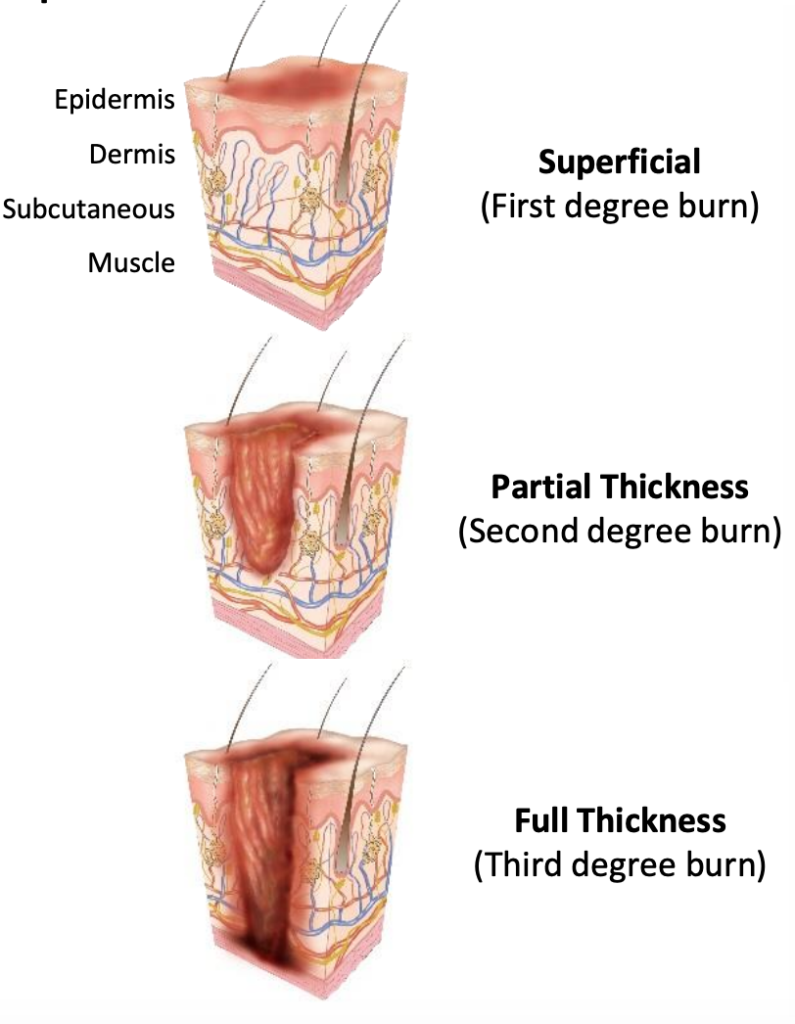More Burns
Published .

Burns are injuries of the skin involving the two layers: the thin, outer epidermis and the thicker, deeper dermis. 86% of burns are caused by thermal injury, while about 4% are electrical and 3% are chemical. A variety of factors guides the evaluation and management of burns. First is the type of burn such as thermal, chemical, electrical or radiation. Second is the extent of the burn usually expressed as the percentage of total body surface area (%TBSA) involved. Next is the depth of the burn described as superficial (first degree), partial (second degree) or full thickness (third degree). Finally, other factors include specific patient characteristics like the age of the patient (< 10 or > 50 years old); other medical or health problems; if there are specialized locations of the burn (face, eyes, ears, nose, hands, feet and perineum); and if there are any associated injuries, particularly smoke inhalation and other traumatic injuries.
Burns may be caused by:
- Abuse
- Chemicals such as strong acids, lye, paint thinner or gasoline
- Electric currents
- Fire
- Hot liquid
- Hot metal, glass or other objects
- Steam
- Radiation from x-rays
- Sunlight or ultraviolet light
Approximately 86% of burns are caused by thermal injury, while about 4% are electrical and 3% are chemical. Flame and scald burns are the leading cause of burns in children and adults. More adults are injured with flame burns while children younger than five years old are more often injured with scald burns. Burn injuries more commonly affect people of low and middle income and people in low-income countries.
Burns are injuries of the skin involving the two main layers – the thin, outer epidermis and the thicker, deeper dermis. There are various types of burns. Chemical burns are divided into acid or alkali burns. Alkali burns tend to be more severe causing more penetration deeper into the skin by liquefying the skin (liquefaction necrosis). Acid burns penetrate less because they cause a coagulation injury (coagulation necrosis). Electrical burns can be deceiving with small entry and exit wounds, however, there may be extensive internal organ injury or associated traumatic injuries. Thermal burns are the most common type of burn. Most burns are small and superficial causing only local injuries. However, burns can be larger and deeper, and patients can also have a systemic response to severe burns.
The major factors to consider when evaluating the burned skin are the extent of the burns (usually calculated by the percentage of total body surface area (% TBSA) burned) and the estimated depth of the burns (superficial, partial thickness or full thickness)
Depth of the Burn

Burn depth is classified into one of three types based on how deeply into the epidermis or dermis the injury might extend.
- Superficial burns (First Degree) involve only the epidermis and are warm, painful, red, soft and blanch when touched. Usually, there is no blistering. A typical example is a sunburn.
- Partial thickness burns (Second Degree) extend through the epidermis and into the dermis. The depth into the dermis can vary (superficial or deep dermis). These burns are typically very painful, red, blistered, moist, soft and blanch when touched. Examples include burns from hot surfaces, hot liquids or flame.
- Full-thickness burns (Third Degree) extend through both the epidermis and dermis and into the subcutaneous fat or deeper. These burns have little or no pain, can be white, brown, or charred and feel firm and leathery to palpation with no blanching. These occur from a flame, hot liquids, or superheated gasses.
When calculating the extent of burn, only partial thickness and full thickness burns are considered, and superficial burns are excluded. Burn centers provide special debridement (removal of burnt skin) and wound care to burn patients. EMS should transport a patient to a burn center who meets the following conditions:
- partial thickness burns greater than 10% total body surface area
- full thickness burns
- burns of the face, hands, feet, genitalia, or major joints
- chemical burns, electrical, or lighting strike injuries
- significant inhalation injuries
- burns in patients with multiple medical disorders
- burns in patients with associated traumatic injuries
